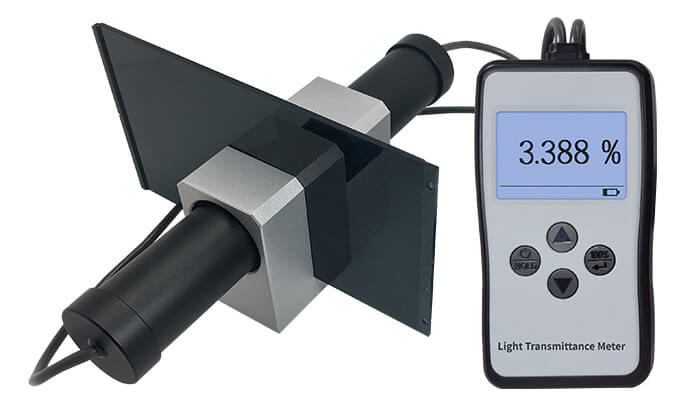
86116 Light Transmittance Meter
Suitable for testing regular transmittance materials
Used for glass, organic materials and other transparent materials transmittance measurement
The parallel optical path design enables to measure large thickness materials
Accuracy: ±1%, measuring range: 0.001%-99.8%
86116 light transmittance tester is a professional instrument for testing the light transmittance of uniform light-transmitting materials. It uses a parallel light path design and can also be used to detect large thickness materials with an accuracy of ± 1% which is to ensure passing the testing of the metrology Institute. Light transmittance is an important technical indicator of many optical products, such as glass, solar film, laminated glass, PC plastic, etc. The test principle of the light transmittance meter is to use a visible light source to illuminate the measured substance. The sensor detects the incident light intensity of the light source and the light intensity after passing through the measured substance. The ratio of the transmitted light intensity to the incident light intensity is transmitted. Rate, expressed as a percentage.
Application
The 86116 light transmittance meter can be used to test the light transmittance of glass products, solar films, laminated glass, coating materials, organic material panels and other materials. Suitable for display, production, quality inspection, inspection and other occasions.

86116 tests film glass

86116 tests large thickness double glazing

86116 tests solar film

86116 tests transpraent glass
Parameters
| Parameter | Value |
|---|---|
| Light Source | 380nm-760nm full wavelength, in line with CIE photopic luminosity function |
| Measurement Accuracy | ± 1% (colorless and uniform transparent materials) |
| Resolution | 0.001% (0% - 10%) 0.01% (10% - 100%) |
| Test Sample Thickness | Less than 100mm |
| Test Sample Diameter | 10mm |
| Display | 240 * 160 dot-matrixes LCD |
| Weight | about 622g (without battery) |
| Dimension | 148mm * 76mm * 26mm (L*W*H) |
| Power Supply | 4 AAA alkaline dry battery |

Features
High resolution, high permeability samples can be measured
Adopt high-resolution acquisition chip, which can realize high-precision data acquisition, fast response and real-time dynamic calibration, high measurement accuracy and fast test speed. The instrument can measure high-transmittance samples. The transmittance measurement range is 0.001% -99.8%, and its resolution can reach 0.001%


Parallel light path of the light source
86116 is designed with a parallel light path and receiver spotting, allowing to measure large thickness materials
High measurement accuracy and speed
The meter uses a high-resolution 24-bit ADC acquisition chip, so that the overall performance of the sensor within the instrument can be improved including computing speed, response speed as well as dynamic calibration and obtain high resolution
Two measurement ways for flexible to use
Equipped with a fixed base, with two measurement methods, therefore it is suitable for testing on-site measurement of automobile front glass, and also suitable for fixed-point light transmission measurement such as a fixed station in a factory

Field measurement

Pedestal measurement
Packing
| No. | Description | Quantity | Unit |
|---|---|---|---|
| 1 | 86116 Light Transmittance Meter | 1 | pcs |
| 2 | User Manual | 1 | pcs |
| 3 | Certificate / Warranty Card | 1 | pcs |
| 4 | Pedestal | 1 | pcs |
| 5 | Packing Box Dimension 34*29*9 cm(L*W*H) | 1 | pcs |

FAQ
-
1. The difference between 86116 and 86110 light transmittance meters
86110 light transmittance meter use the design of main and auxiliary machine separation, no connecting line and contains three independent light sources. The measured light transmittance value is the average of the three data. The size of the measured material needs to be greater than 40*40mm. It is suitable for measuring car front windshield and installed architectural glass, etc.
The 86116 light transmittance meter has a connecting wire and a fixed base. The accuracy is higher than that of the 86110. It is mainly used for the light transmittance detection of glass, organic materials, window films and other transparent materials. It can test transparent materials with a diameter greater than 10mm.
-
2. The difference between 86116 and 86117 light transmittance meters
86116 is suitable for measuring the light transmittance of transparent and regular materials. The diameter of the tested material must be greater than 10mm;
86117 is mainly suitable for measuring the light transmittance of opalescent, frosted fog, diffuse transmission materials and low-transmittance materials (at the same time it can measure the optical density value).The diameter of the measured material should be greater than 2mm.
-
3. How to calibrate the 86116 light transmittance meter and how often do I need to calibrate?
The 86116 light transmittance meter has a real-time dynamic self-calibration function, without the need for other tools such as standard films to assist calibration. Without placing any material under test, as long as the instrument passes self-calibration and displays 100%, the light transmittance test can be performed. The instrument accuracy is also guaranteed to meet the factory standards.